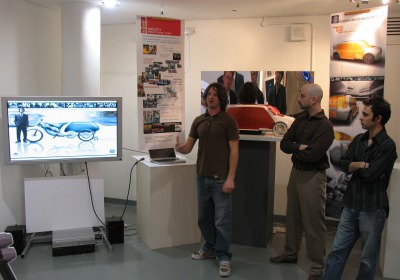College Exhibition: Royal College of Art - GE Plasticon project
Mon, 08 May 2006Postgraduate students at London's Royal College of Art recently presented the results of a multi-disciplinary design project in collaboration with GE Plastics. As part of the 'PLASTicon' project, 17 RCA first year MA students researched, designed and built models of concept vehicles aimed at the needs of different markets - from SUV owners to Gen-Y consumers - utilising the capabilities of plastics.
Beginning in December, the students from the Vehicle Design course as well as from Textiles, were split into six teams tasked with conducting research into specific scenarios, including emerging generations and emerging markets to meet specific challenges of today and tomorrow. Once the research was complete, each individual team member designed and built their own personal interpretation of the scenario.
Material icons: Plastic form language
Ana Zadnik, Flavien Dachet, Daniel Sjoholm, Yuko Kanemura
This group concentrated on the unique properties of plastic and explored different ways to manipulate it to create new textures, patterns and lighting effects from the material itself.
The framework of Ana Zadnik's vehicle is made of a stretched plastic form over a variable-length flexing metal structure, which enables easier transportation and allows customers to choose the length of the vehicle.
Taking inspiration from celebrity culture and graffiti design, Daniel Sjoholm's ideal customer for his vehicle design is singer Bjork. The nature and colours of Iceland worked as an input for the form and colour of the vehicle. The car is also electric and has four wheel drive, ideal for visits to the Icelandic countryside or arriving in style at VIP parties as the car's unique properties stand out in a crowd.
Yuko Kanemura (a Textiles student) used etched copper sheets laminated in thermochromatic plastic for a vehicle exterior. When the engine is on the heat is conducted through the copper and transferred to the plastic, causing subtle colour changes to expose patterns in the metal.
The car returns to its original colour when the engine is switched off. Yuko also flattened plastic pellets to resemble mosaics which were then laminated to form sheets to use for the car interior.
Flavien Dachet used the texture and transparency of plastic pellets and backlighting to create a random light constellation for vehicle interiors. The random mosaic pattern achieved in the forming process give a bespoke feeling to each dashboard.
Mobility icons: China
Filip Krnja, Ehsan Moghaddampour, Jamie Tomkins
The challenge for this group was to create suitable transport for this increasingly populated country that meets the needs of urbanites as well as complying with Chinese government policy to encourage the use of low or non-emission vehicles. After a research trip to China, the team developed vehicles based on a future concept of the city - the Beijing Boom Tower which is designed into three tiers or social classes. On the top tier live the wealthiest residents, in the centre are the middle-classes, and at the bottom live the working class. A vehicle for each level was designed.
Filip Krnja designed for the top level penthouses, each with its own personal lift. The inside of the lift doubles as the car cabin - meaning the lift takes the resident straight from their apartment and slots into the middle section of the car. The vehicle is programmable to take the occupant straight to their destination with no need for manual driving.
Ehsan Moghaddampour looked at the middle level and has designed a taxi. The shape of the taxi was influenced by Chinese buildings and the main feature is concertina doors, ideal for cramped Chinese streets.
Jamie Tomkins took on the bottom level and looked at the ubiquitous Chinese bicycle as a starting point for his design. His hybrid bicycle has a metal and plastic frame with plastic detachable parts that can be changed to create a unique style. The use of plastic means the hybrid is lighter and with interchangeable parts it is more aesthetically pleasing to the eye.
Material icons: Plastic technology opportunities
Francisco Avila Anon, Teresa Mendicino, Julien Cueff, Laura Perryman
The challenge for this team was to design a vehicle that would make commuting more enjoyable and relaxing. The team used the theme of 'emotions through plastic'. Opportunities identified by the team included: see-through exteriors; new door openings enabled by lightweight plastic; light conductivity possibilities of plastic; and how using plastic can enable the inside of a vehicle to be changed.
Teresa Mendicino's interior concept features a roof containing LED's to give the impression of a starry sky to help the driver and passengers imagine they are far away from the traffic congestion and pollution. The design can also be personalized, through the use of graphics and thermochromatic materials.
Plastic material enabled Julien Cueff to define new uses and functionalities and to design an exterior that was closer to human nature and behaviours.
Laura Perryman (Textiles student) used natural and organic structures to inform the prints for the vehicles. Translucency and colour play a big part in the overall aesthetic, with organic flowing patterns based on sound waves. Vacuum forming combined with a range of experimental prints gave a new quality, feel and touch that is reactive to the user. Pattern is revealed with surface change, reacting to light and temperature.
Continues...
By

